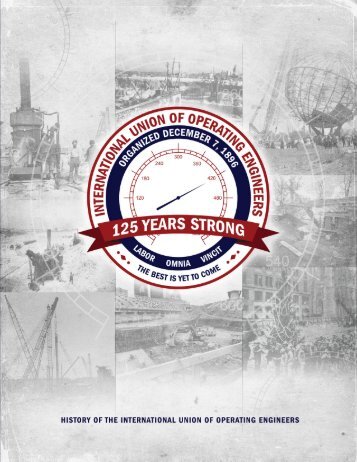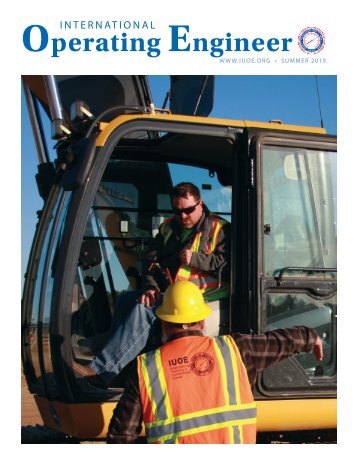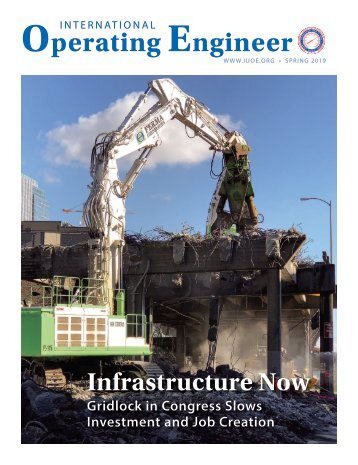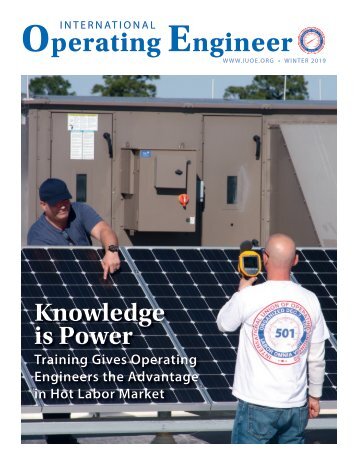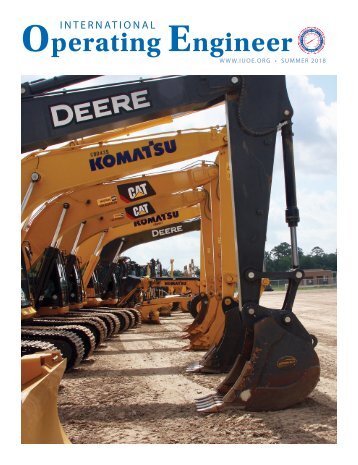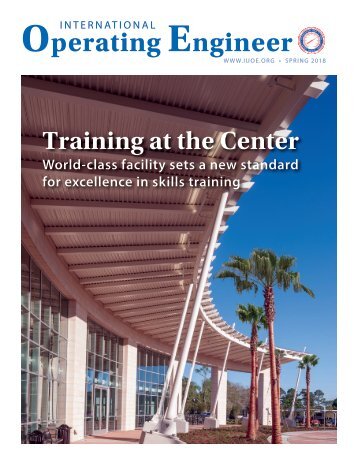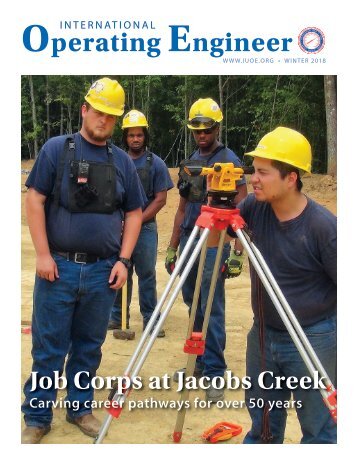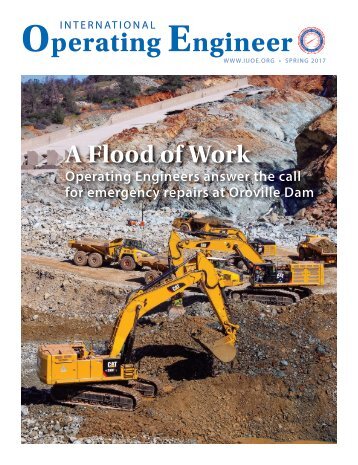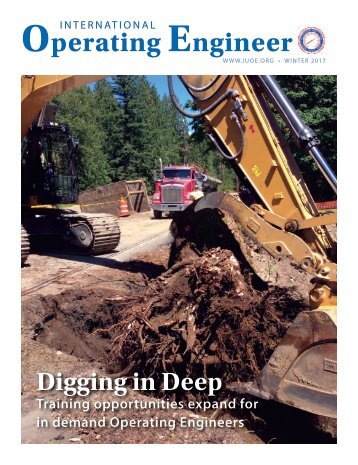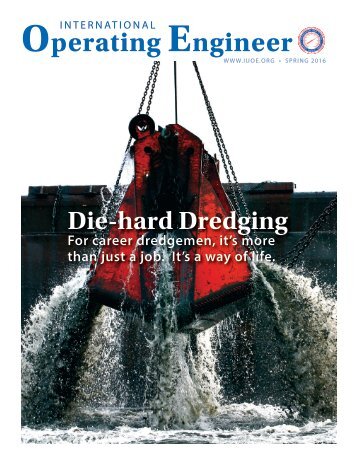International Operating Engineer - Spring 2017
- Text
- Operating
- Iuoe
- Engineer
- Engineers
- Infrastructure
- Spillway
Healthcare An Ounce of
Healthcare An Ounce of Prevention is Worth a Pound of Cure MEDICINE IS PRIMARILY focused on treating illness after it happens. What can we do as IUOE members to better our health and prevent illness? The U.S. National physical activity guidelines recommend 150 minutes of moderate activity or 75 minutes of vigorous activity each week (60 mins a day for kids). Physical activity can mean the gym or it can mean walking the dog, gardening or simply taking the steps versus the elevator. Exercise can help all aspects of your life from weight, memory, concentration, mood, stress and sleep. Exercise can also lower high blood pressure and cholesterol and lower your risk of getting diabetes. High blood pressure? It is a good indication of the health of your cardiovascular system. When your blood pressure is high, it’s working under stressful conditions. Your body weight is one major influence on your blood pressure. Type 2 diabetes or pre-diabetic? Diabetes type 2, primarily a preventable disease, ranks among the most expensive diseases in the United States. You can cut your risk of getting type 2 diabetes by exercising, reducing your weight with a low fat, high fiber diet. High cholesterol? Exercise can lower cholesterol by helping you lose or maintain weight. Being overweight tends to increase low-density lipoprotein (LDL) in your blood, which is linked to heart disease. There’s no “perfect weight” that fits everyone. BMI, or body mass index, measures how healthy your weight is based on how tall you are. It gives you a clue to your risk for weight-related health problems. What is your Body Mass Index (BMI)? Try WebMD’s BMI calculator: http://www.webmd.com/ diet/body-bmi-calculator Consult your doctor today for a physical and assess your family’s risks for these sometimes preventable conditions. Top 10 prescription drugs used by IUOE CVS members are: #1 Atorvastatin Calcium Cholesterol, 72K scripts #2 Lisinopril, High Blood Pressure, 63K scripts #3 Amlodipine Besylate High Blood Pressure, 46K scripts #4 Omeprazole Reflux Disease, 44K scripts #5 Metoprolol Succinate High Blood Pressure, 33K scripts #6 Metformin Hcl Diabetes, 36K scripts #7 Simvastatin Cholesterol, 32K scripts #8 Levothyroxine Sodium Thyroid, 32K scripts #9 Hydrochlorothiazide High Blood Pressure, 27K scripts #10 Losartan Potassium High Blood Pressure, 27K scripts Member Spotlight Blood Brother Union member reaches 100-gallon milestone LOCAL 139 MEMBER Brad Morter reached a milestone of 100 gallons of donated blood on March 16 at the American Red Cross Madison Blood Donation Center. He achieved what the organization describes as “elite status” of blood donors and said he plans to continue to regularly donate blood plasma and platelets. Morter joined Operating Engineers Local 139 in 2007. He works for WK Construction Co., a milling contractor from Middleton, Wisconsin. Morter, 60, said he decided to start giving blood in 1979, when an older coworker was diagnosed with cancer and required numerous blood transfusions. “People don’t realize just how easy it is to give blood and help others,” said Morter. “It’s so sad when you see people going through cancer. So this is my way of helping them out.” Not only is Morter a frequent blood donor with the Red Cross, he is an active volunteer for the organization. For nearly 20 years, he has volunteered at blood drives throughout the area and most recently was accepted as a volunteer transportation specialist for the Red Cross. He has B-negative type blood. The platelets he donates are of special need to those receiving cancer treatments and accident victims because the tiny cells form clots and stop bleeding. They also have a relatively long shelf life of five days before they must be transfused. In a process called apheresis, Local 139 member Brad Morter is connected to a centrifuge while donating his 100th gallon of blood. The machine takes his whole blood, spins out plasma and platelets for donation to others, then returns red blood cells to him. Morter typically donates three times a month when he is laid off, during the off-construction season. “We are inspired by Brad’s actions to support the Red Cross and for helping to save lives,” said Sonja Juric, donor recruitment director for the American Red Cross Badger-Hawkeye Blood Services Region. “Blood and platelet donations are needed so patients can receive lifesaving treatments. The joy is ours in telling his story and encouraging others to give blood, volunteer and follow in his footsteps.” Red Cross spokesperson Laura McGuire said donors with blood types O, A-negative and B-negative are encouraged to make a Power Red donation, as Morter has been doing. Power Red donors give a concentrated dose of red blood cells during a single donation, allowing them to maximize their impact. [article & photo] Dave Backmann, IUOE Local 139 8 INTERNATIONAL OPERATING ENGINEER SPRING 2017 9
- Page 1 and 2: i n t e r n at i o n a l Operating
- Page 4: International Operating Engineer (I
- Page 10: Politics & Legislation New Study Sh
- Page 14: Feature The “action” is an inte
- Page 18: Canadian News Remembering the Fort
- Page 22: Union Death Benefit Benefits paid J
- Page 26: International Union of Operating En
Inappropriate
Loading...
Mail this publication
Loading...
Embed
Loading...
International Operating Engineer
HEADQUARTERS
INTERNATIONAL UNION OF OPERATING ENGINEERS (IUOE)
1125 17th Street, NW
Washington, DC 20036
202 429-9100
CONTACT US
Send us an email here.
©2010 International Union of Operating Engineers. All Rights Reserved.|Terms Of Use|Privacy Statement|Sitemap

